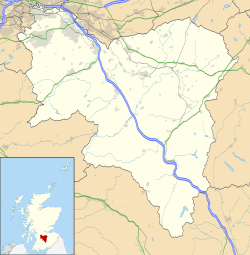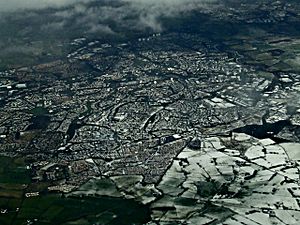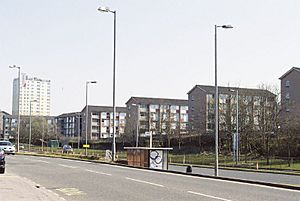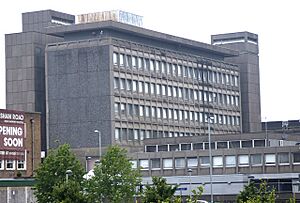East Kilbride facts for kids
Quick facts for kids
East Kilbride
|
|
|---|---|
|
Clockwise from top left: Whitelee Wind Farm, tower of Old Parish Church, Dollan Aqua Centre, Rotten Calder in Calderglen Country Park, St Bride's Church, the National Museum of Rural Life
|
|
| Local authority | South Lanarkshire |
| Country | Scotland |
| Sovereign state | United Kingdom |
| Area | |
| • Total | 26.8 km2 (10.3 sq mi) |
| Population | |
| • Total | 75,310 (2,020) |
| • Language(s) | English |
| Time zone | UTC±0 (Greenwich Mean Time) |
| • Summer (DST) | UTC+1 (British Summer Time) |
| Postcode districts | |
| OS grid reference | NS635545 |
| Railway station | East Kilbride railway station |
East Kilbride (sometimes called EK) is the biggest town in South Lanarkshire, Scotland. It is the sixth-largest town in Scotland by population. East Kilbride was once a small village. On May 6, 1947, it became Scotland's first "new town". This means it was a planned town built to help with housing shortages.
The town is located on a high area south of the Cathkin Braes. It is about 8 miles (13 km) southeast of Glasgow. To the west, the town is near the White Cart Water. To the east, it is bordered by the Rotten Calder Water. The oldest part of town, called The Village, is just north of the modern town centre. East Kilbride is a twin town with Ballerup in Denmark.
Contents
East Kilbride's Story: From Ancient Times to Today
How Old is East Kilbride?
People have lived in the East Kilbride area for a very long time. The earliest signs of people are from the late Stone Age and early Bronze Age. Archaeologists have found burial mounds that were used for ceremonies and burials. These sites often had special stones with markings.
In 1970, a child found a flint arrow head in his garden. Experts later said it was from about 1500 BC, during the Bronze Age. Roman coins and other items have also been found nearby. This suggests that Romans might have been in the wider area.
Where Does the Name East Kilbride Come From?
The town's name comes from an Irish saint named St Bride (or Brigit). She may have started a monastery in Ireland in the 500s. Later, her followers brought her order to parts of Scotland. The word Kil in East Kilbride comes from the Gaelic word cille. This word means "cell" or "chapel" in Latin. It refers to a small church or religious building.
The original church in East Kilbride was built on a spot that might have been important even before Christianity. Some people think it was linked to an old Celtic goddess named Brigid. However, there is no strong proof for this idea. The name "East" was added in the early 1700s to tell it apart from West Kilbride.
Becoming a New Town
East Kilbride grew a lot in the 20th century. In 1930, it was a small village with about 900 people. By 1967, it had become a large town. After World War II, many cities in Scotland, especially Glasgow, had a big housing problem. Glasgow also had bomb damage from the war.
To help solve this, the government decided to build "new towns." These were planned communities designed to take in people from overcrowded cities. East Kilbride was chosen as the first new town in Scotland in 1947. Other new towns followed, like Glenrothes and Cumbernauld.
The town was planned with different areas for homes. Each area has its own shops, primary schools, and community buildings. The main shopping centre is in the middle, surrounded by a ring road. Factories and businesses were built on the edges of the town.
The Calderglen gorge is on the eastern side of East Kilbride. It was known for its beautiful forests and waterfalls. Long ago, a family called the Maxwells of Calderwood lived in Calderwood Castle there. The castle was taken down in 1951.
A famous story from East Kilbride involves workers at the Rolls-Royce factory. From 1974 to 1978, these workers refused to fix jet engines for a military government in Chile. Their story is told in the 2018 film Nae Pasaran. A monument with one of the unrepaired engines was placed at South Lanarkshire College in 2019.
East Kilbride's Location and Layout
Hamilton, where the main offices for South Lanarkshire Council are, is about 5 miles (8 km) east of East Kilbride. The A725 road connects the towns. It also links to major motorways like the M74 and M8.
The Glasgow area of Castlemilk is about 3 miles (5 km) northwest. The Cathkin Braes and the village of Carmunnock are between them. A bypass road was built in 1988 to help traffic avoid Carmunnock. Other nearby towns include Rutherglen and Cambuslang to the northeast. They are connected by the A749 road.
Clarkston and Busby are about 3 miles (5 km) northwest via the A727 road. Eaglesham is about 3 miles (5 km) west. A modern bypass, the Glasgow Southern Orbital, helps traffic heading for the M77 motorway avoid Eaglesham.
To the south, the closest town is Strathaven, about 7 miles (11 km) away. Much of the land in between is covered by Whitelee Wind Farm. This is a large wind farm on the moorland hills.
East Kilbride is often seen as part of the larger Glasgow area. However, it was designed to be a town that could stand on its own. It has its own neighbourhoods, each with homes, local shops, and primary schools. These areas are connected by paths and underpasses, making it safe for people to walk and cycle.
How East Kilbride is Governed
The East Kilbride Civic Centre was finished in 1968. From 1975 to 1996, East Kilbride had its own local government council. Now, the South Lanarkshire council manages the town.
East Kilbride also has its own representatives in the Scottish Parliament and the UK Parliament. These politicians work to represent the people of East Kilbride and the surrounding areas.
What East Kilbride is Known For: Economy and Culture
Shopping and Jobs
East Kilbride has a very large shopping centre. It has six connected malls. This makes it a major place for shopping in the area. There are plans to update parts of the shopping centre and add more homes.
A government office, now called the Foreign, Commonwealth and Development Office, is also located in East Kilbride. This office helps with international development.
Places of Worship
East Kilbride has many Christian churches, including Church of Scotland, Baptist, and Roman Catholic churches. St Bride's RC church is a very old and important building. There is also a Lutheran church, an Evangelical Christian church, and a meeting hall for The Church of Jesus Christ of Latter Day Saints. Two groups of Jehovah's Witnesses share a Kingdom Hall. An Islamic Centre opened in 2018.
Getting Around East Kilbride
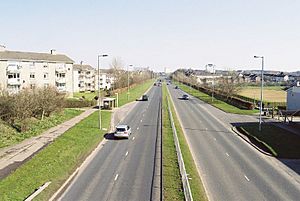
East Kilbride is well-connected to Glasgow by roads and trains. Three main roads link the town to nearby areas and the city. The Glasgow Southern Orbital road connects the west of town to Newton Mearns and the M77 motorway.
The town is famous for its many roundabouts. People sometimes jokingly call East Kilbride "Polo mint City" because of them. The main north-south road is called the Kingsway. The main east-west road is called the Queensway.
Public Transport
The East Kilbride bus station is next to the East Kilbride Shopping Centre. It was rebuilt in 2005 and has modern facilities. Buses run regularly to Glasgow city centre and many other towns.
The East Kilbride railway station is in The Village. Trains go to Glasgow Central railway station every half-hour. The town also has another train station called Hairmyres railway station.
Cycling
East Kilbride has many underpasses at busy roundabouts. These allow people to cycle and walk safely across roads. There are also three special cycle routes that start at the East Kilbride Shopping Centre. These routes go to places like Strathaven and Calderglen Country Park.
Fun Things to Do and See
East Kilbride was designed to have lots of places for fun, sports, and learning about history.
- The James Hamilton Heritage Park has a large man-made loch. You can do water sports there. Next to it is the 15th-century Mains Castle.
- The Dollan Baths is a famous leisure centre that opened in 1968. It has a swimming pool that was the first champion-sized pool in Scotland. It was inspired by famous buildings in Rome and Japan. The Aqua Centre was updated in 2011.
- Long Calderwood Farm used to be the Hunter House Museum. It showed things about famous doctors William and John Hunter, who were born there. Now it is a café.
- East Kilbride Central Library has many books and some local history items.
- St Bride's Church is a special building designed by famous architects and built between 1957 and 1964.
- Langlands Moss is a local nature reserve. It is a special type of peat bog.
- The National Museum of Rural Life is at Wester Kittochside Farm. It shows how farming was done in the 1700s. You can even take a tractor ride between the old farm and the modern museum building.
The town also has the East Kilbride Arts Centre and the Village Theatre for shows and performances.
Sports in East Kilbride
East Kilbride has many sports teams:
- East Kilbride F.C. is a football club that plays at the K-Park Training Academy.
- Motherwell Women F.C also play many of their home games at K-Park.
- East Kilbride Thistle Juniors is another football club.
- East Kilbride YM FC is the town's oldest football club, started in 1921.
- East Kilbride RFC is a rugby club that started in 1968. They play at the Torrance House Arena.
- East Kilbride Pirates are the top American football team in Scotland.
- EK82 Handball Club trains at the John Wright Sports Centre.
Twin Town
East Kilbride has been twinned with Ballerup, Denmark, since 1965.
Schools in East Kilbride
Primary Schools
- Auldhouse Primary School
- Blacklaw Primary School
- Canberra Primary School
- Castlefield Primary School
- Crosshouse Primary School
- East Milton Primary School
- Greenhills Primary School
- Halfmerke Primary School
- Heathery Knowe Primary School
- Hunter Primary School
- Kirktonholme Primary School
- Long Calderwood Primary School
- Maxwellton Primary School/Greenburn Primary School
- Mossneuk Primary School
- Mount Cameron Primary School
- Murray Primary School
- Our Lady of Lourdes Primary School
- South Park Primary School
- St. Hilary's Primary School
- St. Kenneth's Primary School
- St. Leonard's Primary School
- St. Louise's Primary School
- St. Vincent's Primary School
Schools for Additional Support Needs
- Greenburn Primary School
- West Mains School
High Schools
- Calderglen High School
- Duncanrig Secondary School
- St Andrew's and St Bride's High School
Schools for Additional Support Needs
- Sanderson High School
Further Education
- South Lanarkshire College
Famous People from East Kilbride
Many well-known people have connections to East Kilbride:
- Jim and William Reid: Members of the band The Jesus and Mary Chain.
- Alan McGee: Co-founder of Creation Records, a famous music label.
- Roddy Frame: Lead singer of the band Aztec Camera.
- John Hannah: An actor known for films like Four Weddings and a Funeral.
- Julie Wilson Nimmo: An actress known for Balamory.
- Kirsty Young: A TV presenter.
- Lorraine Kelly: A TV presenter who went to school in East Kilbride.
- Ally McCoist: A famous former footballer who went to primary and high school in East Kilbride.
- Hiding Place (band): A Scottish band.
See also
 In Spanish: East Kilbride para niños
In Spanish: East Kilbride para niños








